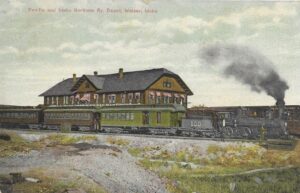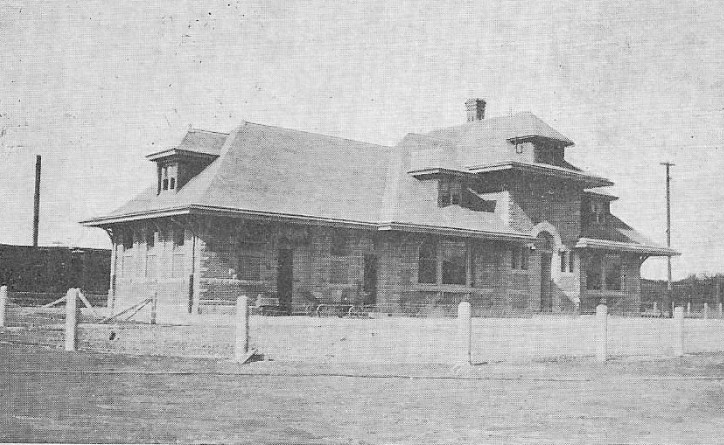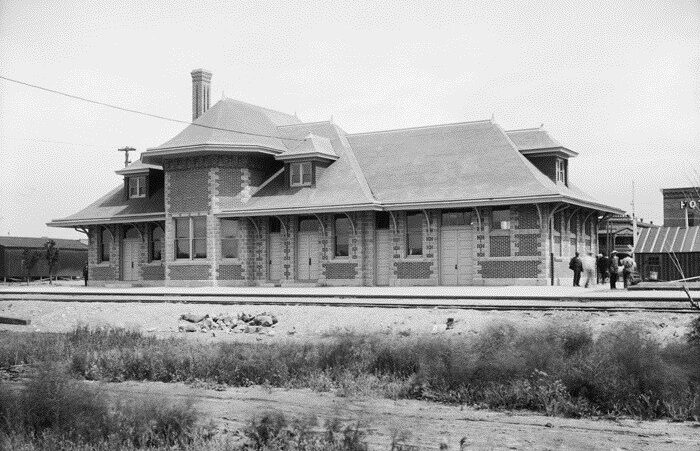In 1884, the Oregon Short Line (subsidiary of Union Pacific RR) made its way west through Idaho and on into Oregon. The little town of Weiser was still 3 years from incorporating as a City and was situated mostly east of the present Highway 95 in what we now call “Old Town”. Typically, commerce and therefore townsites would center around depot locations selected by the railroad and Weiser would eventually be no exception, though our story has its unique twists. Some enterprising entrepreneurs speculated the depot would be sited south of town near Crystal, so constructed a few buildings in that location hoping to capitalize on their timing. OSL fooled them and constructed a wood frame depot not far from the brick building you see today. At the time (about 1887), the location was pretty much on the western outskirts of “Old Town”.
While the old wooden depot survived for many years as a freight station, the new depot soon became the southern terminus where the PI&N (Pacific & Idaho Northern) connected to the OSL. Intended to service the mining districts in central Idaho, 84 miles of track were laid north generally paralleling the Weiser River. PI&N constructed grand two-story depots, one of brick in Council and a frame structure a short distance from the OSL depot here in Weiser.

For years, the PI&N’s “Galloping Goose” as it was affectionately known, transported locals to vacations in McCall as well as freight and commerce between the upper country and points south. Just south across the tracks from the OSL depot was a venue called “Mortimer’s Island”. For many summers, it was the place to go for dances, performances, skating, and just a good time in general. Weiser thrived in those years, but by the late 1960’s and early ‘70’s, transportation, commerce, and lifestyles were changing.
Any inconvenience this location created for our citizens didn’t last long, for in 1890 a devastating fire leveled most of the business district in “Old Town”. Rebuilding gravitated west around the depot and by 1907 the OSL was ready to construct grander and more permanent structures at their locations in Weiser, Payette, Ontario, and Caldwell. All designed following the same floor plan, each incorporated unique exterior details.


A visitor exiting the Weiser depot was greeted with an overhead illuminated sign stretching across State Street before them. Within a block could be found two hotels and numerous shops and entertainment.
The PI&N depot and old OSL freight depot were both gone. In fact, UPRR had discontinued passenger service from Weiser and all that remained was a freight clerk. All three of our major hotels had either burned down or were demolished. While our depot had survived, its decorative dormers had been removed in a reroofing and the interior had accumulated multiple coats of paint. Interior remodeling included removal of the old ticket window in favor of a long counter and the addition of a walled office in the corner of one waiting room. Some exterior doors were closed off and the large double entry doors were replaced by a single, small door. A large chunk of the east exterior brick wall of the freight room was opened to load freight from an elevated interior platform which was also added. We weren’t alone as these trends were impacting many towns across the country whose depots were abandoned or demolished altogether. With no passengers to serve, ours like many depots which survived, became little more than shells of their former selves whose purpose had been reduced to sheltering skeleton rail staff handling freight. So it came as no real surprise when one evening in 1985, one of our members got a call from a preservationist in Payette warning us that UPRR had just demolished their depot and were headed to Weiser in the coming days to do the same!
WAPC quickly got into action and began negotiations with UPRR. We contracted a planner to develop the site plan you see today.

Community outreach and fundraising quickly got underway and so began a two-year process to secure our depot. By early 1987 UPRR had agreed to donate the building and enter into a long-term lease of the underlying property but were unwilling to transact this arrangement with our group. It seemed some of their past donations to well-intentioned groups eventually ran aground, leaving depots abandoned and a liability to the RR. They were willing to transact this arrangement with the City of Weiser, but City officials made it clear to us they had no use for a depot. Knowing we weren’t saving just a historic structure but perhaps a key component of any future downtown revitalization effort, we negotiated with the city to accept the agreement and then transfer the building and lease to WAPC thereafter. This was accomplished and so began the long challenge for WAPC to bring our depot back to life.
We set about implementing our site plan and UPRR soon donated a historic caboose which was moved to the newly re-created park. We installed the trackside security fence required by our agreement with UPRR and the exterior was stabilized and painted. But many of the structural changes UPRR had made through the years, such as the elevated freight dock on the east end of the building, dormer removal and interior wall alterations and missing doors represented major economic challenges, say nothing of the new roof that was needed. We engaged in many fundraising efforts from commemorative bricks to mugs, Christmas ornaments, and just about anything to raise resources to maintain the building. By 2000, the downtown revitalization we’d dreamed about had begun. The city secured a variety of grants, one specifically targeting historic transportation related structures that resulted in the installation of a new roof as well as street, sidewalks, curbs and gutters.





